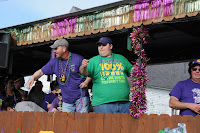Scenes from the Mardi Gras Parade In Jennings, Louisiana on Saturday, March 2, 2019
"Barry Jean Ancelet, Cajun historian and head of the University of Louisiana at Lafayette Folklore Department, has explained the origin of the Courir as being in rural medieval France:
In a nutshell, the country Mardi Gras comes from the way Mardi Gras was celebrated in France in the rural section as opposed to the urban carnival. It’s an early springtime renewal and is essentially a way for communities to celebrate and find themselvesThese origins are in the customs of Catholic medieval Europe, specifically the fête de la quémande ("feast of begging") of medieval France.[1] During the fête, which was a time when begging from house to house was a socially acceptable behavior, disguised revelers would go through the countryside visiting households and performing for offerings. This is similar to other contemporary traditional European customs such as mumming and wassailing which usually occur around Christmas, New Year's, and Epiphany. These traditions originated in a time when most of the land and money was held by the upper classes. The poor, at the end of long winters and short on food, would gather in groups and make their way from castle to manor house to beg for food from the wealthy, dancing and singing in return for the generosity of the nobles.[5] French medieval carnival celebrations also featured contests and races, which may be the origins of the chicken chase associated with the courir.[6] A few of the traditional runs have whipping and penitinece as part of their traditions. These traditions are traced to the Medieval Flagellants, who would hold processions through the streets whipping themselves and sometimes onlookers to beat the sin out of them.[7] Other of the traditions associated with the courir are derived from the folk traditions of Pre-Christian Celtic Europe and are associated with fertility and renewal. Examples include the use of the burlap whip and the tune on which the Chanson de Mardi Gras are based, both of which are traced back to Brittany, a Celtic enclave on the Northwestern French coast near where the original settlers of Acadia were from.[7][8] These traditions were carried to North America by European immigrants during the 17th and 18th centuries.[6] In the mid to late 18th century when the Acadian settlers of the Canadian Maritimes were forcibly deported by the English, many made their way to South Louisiana, settling what would become known as the Acadiana region. The Cajuns, as they would become known to the rest of the world, have held on to many of their traditional customs, including their language (Acadian French became Cajun French), music, dances and religious festivals such as the courir.[9] This determination to hold on to their religious customs and faith has been a major factor in creating the atmosphere that has allowed for the celebration of life, or "la joie de vivre," that is so characteristic of Cajun life and culture in South Louisiana.[10]
— Barry Ancelet[4]












































No comments:
Post a Comment